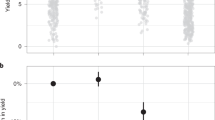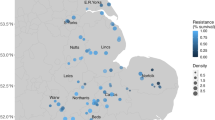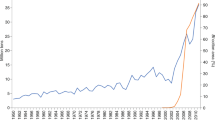Abstract
Breeding new crop varieties with resistance to the biotic stresses that undermine crop yields is tantamount to increasing the amount and quality of biological capital in agriculture. However, the success of genes that confer resistance to pests induces a co-evolutionary response that depreciates the biological capital embodied in the crop, as pests evolve the capacity to overcome the crop's new defences. Thus, simply maintaining this biological capital, and the beneficial production and economic outcomes it bestows, requires continual reinvestment in new crop defences. Here we use observed and modelled data on stripe rust occurrence to gauge changes in the geographic spread of the disease over recent decades. We document a significant increase in the spread of stripe rust since 1960, with 88% of the world's wheat production now susceptible to infection. Using a probabilistic Monte Carlo simulation model we estimate that 5.47 million tonnes of wheat are lost to the pathogen each year, equivalent to a loss of US$979 million per year. Comparing the cost of developing stripe-rust-resistant varieties of wheat with the cost of stripe-rust-induced yield losses, we estimate that a sustained annual research investment of at least US$32 million into stripe rust resistance is economically justified.
This is a preview of subscription content, access via your institution
Access options
Subscribe to this journal
Receive 12 digital issues and online access to articles
$119.00 per year
only $9.92 per issue
Buy this article
- Purchase on Springer Link
- Instant access to full article PDF
Prices may be subject to local taxes which are calculated during checkout


Similar content being viewed by others
References
FAOSTAT (FAO, 2015); http://faostat.fao.org
Beddow, J. M. & Pardey, P. G. Moving matters: the effect of location on crop production. J. Econ. Hist. 75, 219–249 (2015).
Stakman, E. C. & Harrar, J. G. in Principles of Plant Pathology Ch. 12 (Ronald, 1957).
Hanson, H., Borlaug, N. E. & Anderson, R. G. in Wheat in the Third World Ch. 9 (Westview, 1982).
Goyal, A. & Manoharachary, C. (eds) Future Challenges in Crop Protection Against Fungal Pathogens (Springer, 2014).
Wellings, C. R. Global status of stripe rust: a review of historical and current threats. Euphytica 179, 129–141 (2011).
Milus, E. A., Kristensen, K. & Hovmøller, M. Evidence for increased aggressiveness in a recent widespread strain of Puccinia striiformis f. sp. tritici causing stripe rust of wheat. Phytopathology 99, 89–94 (2009).
Saari, E. E. & Prescott, J. M. in The Cereal Rusts (eds Roelfs, A. P. & Bushnell, W. R .) Ch. 9 (Academic, 1985).
Loladze, A., Druml, T. & Wellings, C. R. Temperature adaptation in Australasian populations of Puccinia striiformis f. sp. tritici. Plant Path. 63, 572–580 (2014).
Shaner, G., Stromberg, E. L., Lacy, G. H., Barker, K. R. & Pirone, T. P. Nomenclature and concepts of pathogenicity and virulence. Ann. Rev. Phytopath. 30, 47–66 (1992).
Wellings, C. R. Puccinia striiformis in Australia: A review of the incursion, evolution, and adaptation of stripe rust in the period 1979–2006. Aust. J. Ag. Res. 58, 567–575 (2007).
Pretorius, Z. A., Pakendorf, K. W., Marais, G. F., Prins, R. & Komen, J. S. Challenges for sustainable rust control in South Africa. Aust. J. Ag. Res. 58, 593–601 (2007).
Hovmøller, M. S., Justesen, A. F. & Brown, J. K. M. Clonality and long distance migration of Puccinia striiformis f. sp. tritici in north-west Europe. Plant Path. 51, 24–32 (2002).
Small grain losses due to rust USDA; http://www.ars.usda.gov/main/docs.htm?docid=10123
Chai, Y., Kriticos, D. J., Beddow, J. M., Duveiller, E. & Sutherst, R. Puccinia striiformis Pest Geography (InSTePP-HarvestChoice, 2014).
Murray, G. M., Ellison, P. J., Watson, A. & Cullis, B. R. The relationship between wheat yield and stripe rust as affected by length of epidemic and temperature at the grain development stage of crop growth. Plant Path. 43, 397–405 (1994).
Hurley, T. M., Rao, X. & Pardey, P. G. Re-examining the reported rates of return to food and agricultural research and development. Am. J. Ag. Econ. 96, 1492–1504 (2014).
Hovmøller, M. S., Walter, S. & Justesen, A. F. Escalating threat of wheat rusts. Science 23, 369 (2010).
Pardey, P. G. et al. Right-sizing stem-rust research. Science 340, 147–148 (2013).
You, L. et al. Spatial Production Allocation Model (SPAM) 2005 v2.0 (International Food Policy Research Institute, 2014); http://mapspam.info
Pardey, P. G. et al. A bounds analysis of world food futures: global agriculture through to 2050. Aust. J. Ag. Resour. Econ. 58, 571–589 (2014).
Acknowledgements
We thank R. Singh for technical guidance. In addition, attendees of the Borlaug Global Rust Initiative (BGRI) meetings at New Delhi (August 2013) and Obregon, Mexico (March 2014) and the Second International Wheat Stripe Rust Symposium at Izmir, Turkey (April 2014) provided valuable comments and feedback. A substantial portion of the funding was provided by the Wheat CRP by way of the International Maize and Wheat Improvement Center (CIMMYT) with additional support from the University of Minnesota's MnDRIVE Global Food Ventures Initiative and the International Science and Technology Practice and Policy (InSTePP) Center. R.F.P. and W.C. received support from the Australian Grains Research and Development Corporation.
Author information
Authors and Affiliations
Contributions
P.G.P., J.M.B. and T.M.H. designed the study and methods; D.J.K., J.M.B., Y.C., R.F.P., H.J.B., T.Y. and W.S.C. compiled and interpreted distribution data and developed the species niche model; Y.C. and T.M.H. undertook the probabilistic assessment; J.M.B. implemented the spatial assessment; P.G.P., J.M.B., T.M.H., Y.C., R.F.P. and W.S.C. wrote the paper.
Corresponding author
Ethics declarations
Competing interests
The authors declare no competing financial interests.
Supplementary information
Rights and permissions
About this article
Cite this article
Beddow, J., Pardey, P., Chai, Y. et al. Research investment implications of shifts in the global geography of wheat stripe rust. Nature Plants 1, 15132 (2015). https://doi.org/10.1038/nplants.2015.132
Received:
Accepted:
Published:
DOI: https://doi.org/10.1038/nplants.2015.132
This article is cited by
-
Documentation of multi-pathotype durable resistance in exotic wheat genotypes to deadly stripe and leaf rust diseases
Cereal Research Communications (2024)
-
The use of high-throughput DArTseq-based silicoDArT and SNP markers to identify yellow rust resistance genes in common wheat
Euphytica (2024)
-
Identification of synthetic wheat lines with broadly effective stripe rust resistance
Australasian Plant Pathology (2024)
-
A potential biocontrol agent Streptomyces tauricus XF for managing wheat stripe rust
Phytopathology Research (2023)
-
Mycorrhizal colonization and Streptomyces viridosporus HH1 synergistically up-regulate the polyphenol biosynthesis genes in wheat against stripe rust
BMC Plant Biology (2023)



